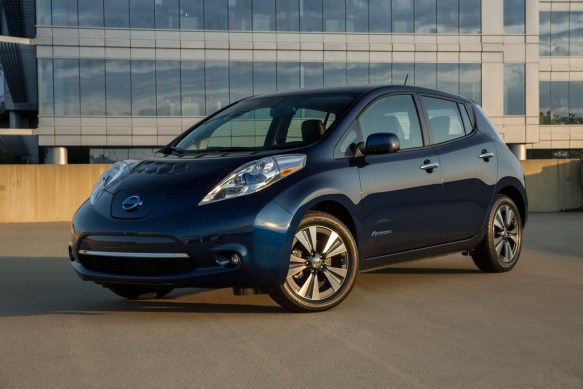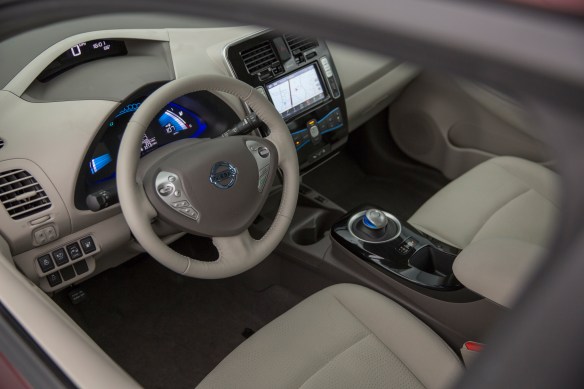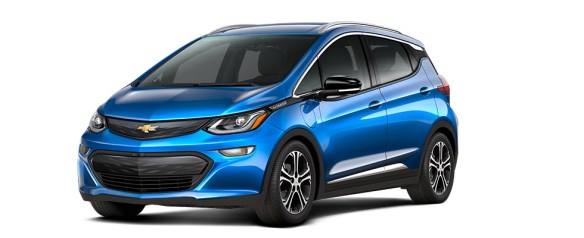
The Nissan Leaf was designed from scratch to be a gas-free all-electric model. They’ve sold more than 185,000 of them since its debut in 2010 as an ‘11, and a pioneer in mainstream EVs.
The Leaf hasn’t changed much over the years, though, until now. The 2016 model looks the same, but you now can get one with a 30 kWh lithium-ion battery. Adding just 46 pounds, it’s got higher power density, so it earns a 107-mile driving range from the EPA, versus 84 for the old 24 kWh battery, a 27 percent improvement.
For most driving, and many people, 107 miles is plenty. I drove my Deep Blue Pearl Leaf back and forth to work every day, in quiet comfort, the Bose audio system pouring out music from the standard Sirius XM radio and Bluetooth-connected selections from my Spotify stream.
The problem comes when you want to drive further. I got home one day with 85 miles on the range meter, and we had to take a quick trip that was about 70 miles. Because I wasn’t sure that was enough, we took our internal combustion engine car.
Although its design is aging, the Leaf feels smooth, solid, and friendly. With its virtually silent and vibration-free 80 kW motor, you fly along, almost by magic. Torque is available from the moment you step on the accelerator pedal, so there’s plenty of hustle from the 107 horsepower and 187 lb.-ft. of torque moving the 3,391-lb. car.
The EPA rates the Leaf at 124 MPGe City, 101 Highway, and 112 Overall. The Smog and Greenhouse Gas numbers are perfect 10s. The Leaf also gives you a miles-per-kWh rating, which was 4.1 for me. With 30 kWh, that looks like about 120 miles per charge.

The one-speed transmission is controlled by a “palm shifter,” which, with its bright blue plastic front edge, reminded me of a Duncan Imperial yoyo. Just slip it back into Drive or forward into Reverse or push the Park button on the top.
The battery below the floor means a low center of gravity, so the Leaf is stable, and you feel secure darting around through traffic. But you are encouraged to drive gently to preserve charge. Nissan gives you a little Eco indicator at the top of the instrument panel, which assembles a little tree. The completed tree shrinks and moves to the lower right and you start on another one. I normally grew two on my 18-mile commute.
Unlike some other EVs, the Leaf is rated as a midsize car, and fits five adults, while providing 24 cubic feet of cargo space with the rear seat up. Drop the rear seat for an additional six cubic feet. I hauled my upright bass with ease, although the storage area isn’t flat—it’s deeper at the rear.
To charge the Leaf, a panel flips up on the car’s nose. In there, you’ll find the standard plug for using a Level 2 (240-volt) charger or a cable to charge (slowly) at home at 120 volts. A Level 2 charge takes about 6 hours. Upper level Leafs include a Quick Charge plug, which lets you refill the battery to 80 percent capacity in half an hour.
The Leaf is so quiet that Nissan provides an “Approaching Vehicle Sound for Pedestrians.” It’s a low-volume beep, which emanates from a speaker under the hood at speeds below 16 mph. I only heard it when backing out of my driveway.
The three models start with the S, the price leader, at $29,860. It comes with push-button start, electric windows, locks and mirrors, air conditioning, and a decent audio system, but gets only the 24 kW battery.
The mid-level SV starts at $35,050. It has the 30 kW battery and the Quick Charge plug. It also features the NissanConnect system with Navigation, a larger 7-inch display screen, two more audio speakers, and 17-inch alloys in place of 16-inch steel wheels.
The SL, at $36,790, is distinguished mainly by its comfortable leather seats. You also get a photovoltaic solar panel on the rear spoiler, heated rear seats, a cargo cover, and a couple other items. My SL tester came with the Premium Package, with an upgraded Bose 7-speaker audio system and the Around View monitor (it gives a bird’s eye view). It topped out at $39,390. All prices listed include the $850 delivery charge.
Retail prices are perhaps irrelevant, since many EVs are leased at bargain rates, and there are government tax credits that can significantly reduce your costs. Figure in that electricity is much cheaper than gasoline and EVs require much less maintenance, and it could be a real bargain.

The Leaf, built in Smyrna, Tennessee, has been the most popular EV out there, and if you’re not budgeted for a Tesla, is still a good option.




